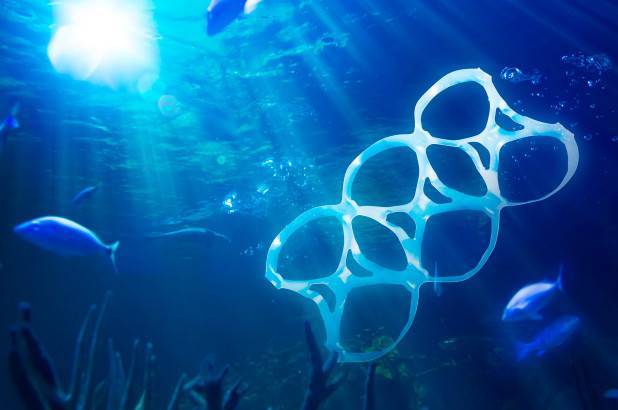
Plastic pollution seeps into the ocean through run-off and even purposeful dumping. The amount of plastic in the Atlantic Ocean has tripled since the 1960s. The garbage patch floating in the Pacific Ocean, almost 620,000 square miles—twice the size of Texas—is a powerful image of our plastic problem.
A huge culprit is single-use plastics, used once before tossed into the trash or directly into the ocean. These single-use items are accidentally consumed by many marine mammals. Plastic bags resemble jellyfish, a common food for sea turtles, while some seabirds eat plastic because it releases a chemical that makes it smell like its natural food. Discarded fishing nets drift for years, ensnaring fish and mammals.

Bits of plastic swirl throughout the water column, even sinking to the deepest depths of the ocean. Scientists found plastic fibers in corals in the Atlantic Ocean—and more concerning, they found that the corals readily ate plastic over food. Dying marine mammals, washing up on shore, also contain plastic inside their stomachs.
Is there a “fix” to marine pollution?
Many “flavors” of marine pollution. Ocean water covers more than 70 percent of the Earth, and only in recent decades have we begun to understand how humans impact this watery habitat. Marine pollution, as distinct from overall water pollution, focuses on human-created products that enter the ocean.
Before 1972, humans around the word spewed trash, sewage sludge, and chemical, industrial, and radioactive wastes into the ocean with impunity. Millions of tons of heavy metals and chemical contaminants, along with thousands of containers of radioactive waste, were purposely thrown into the ocean.
The London Convention, ratified in 1975 by the United States, was the first international agreement to spell out better protection for the marine environment. The agreement implemented regulatory programs and prohibited the disposal of hazardous materials at sea. An updated agreement, the London Protocol, went into effect in 2006, more specifically banning all wastes and materials except for a shortlist of items, like leftover materials from dredging.
Many of these pollutants sink to the ocean’s depths or float far distances from their original source, where they are consumed by small marine organisms and introduced into the global food chain. Marine pollution encompasses many types of pollution that disrupt the marine ecosystem, including chemical, light, noise, and plastic pollution.
Many national laws, as well as international agreements, now forbid dumping of harmful materials into the ocean, although enforcing these regulations remains a challenge.
Many pollutants still persist in the environment, difficult to fully remove. Chemical pollutants often cannot be broken down for long periods of time, or they increase in concentration as they move up the food web. Because plastic is thought to take hundreds of years to break down, it poses a threat to the marine environment for centuries.
Isolated efforts to restore estuaries and bays have met with some success, but pollution gets trapped in marine sediment and makes complete clean-ups nearly impossible.
Moving forward, encouraging recycling and reuse can minimize plastic pollution.
Don’t be hesitate if you like our reusable products, please contact me by the below information.
WhatsApp/WeChat:(+86)13246751686
Email:[email protected]

